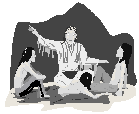Topic #3 Native
People Today
Time: 1-3 period(s)
Objectives:
- Students will recognize that Canada is a
multicultural country made up of people with a
variety of languages, religions, and customs.
- Students will gain an appreciation of the
importance of Canada's Native peoples in the
cultural mosaic.
- Students will learn to value the diverse,
dynamic, and changing cultures of Canada's Native
peoples, the founding peoples, and subsequent
immigrants, which have shaped the Canadian
identity.
- Students should be able to explain the values and
attitudes that underlie decisions made by Native
Peoples about their lives and their futures.
- Student will draw maps, sketches, graphs, and
charts from large and complex maps and databases.
- Students will learn to evaluate recorded
information and assess the reliability of
specific sources of information.
- Students will become comfortable with
interpreting and using information from the World
Wide Web.
Resources:
- Digital Collections: Our Elders: Interviews
With Saskatchewan Elders. http://www.lights.com/sicc/index.html
- Newspaper articles on Native issues, particularly
on Nunavut.
- Canadian Geography textbook
Purpose: To look at the different native
cultures present in Canada today and the contributions
they make to Canadian society.
Ideas:
- Invite an Aboriginal speaker to the class to
discuss their culture and lifestyle now and
compare it to the past or to tell a legend/story.
- Read newspaper articles that involve First
Nations people or issues. Have students write
their own thoughts and reflections about the
articles. Discuss as a group. When discussing
things as a group, it is nice if the students sit
in a circle and each student has a turn going
around the circle to express his/her ideas.
- Have students keep their own scrapbook of
articles with their responses (See Appendix).
Have students use Critical Reading (See Appendix)
- Read articles pertaining to Nunavut (Several have
been published in both the Toronto Star and the
Globe and Mail.). Have students answer questions
such as; What is the date of formation of the new
territory, Nunavut? and Who will be responsible
for Nunavut? Have students draw on a map of
Canada where the new territory will be located.
Have students discuss the pros and cons of the
formation of the new territory. What are some of
the concerns? Again the circle discussion is a
good idea so that each student get to express
his/her opinion.
- Activity based on Internet site: Our Elders:
Interviews with Saskatchewan Elders
( http://www.lights.com/sicc/index.html
). Have each student read a different
interview with one of the Saskatchewan Elders.
Have students write a response describing what it
is like to be a Native Person living in Canada
today. Possible questions might include: Who is
the Elder?, What cultural area are they from?,
What tribal group are they from?, What life
experiences have they had?, What are some of the
changes that are occurring for Native People in
Canada?, etc. Have each student identify people
who are 'elders' in his/her life.

- Discuss with students the social concerns,
economic concerns, and land claims of the Native
People living in Canada. Discuss with students
the difference between Metis, Non-status Indians,
and Status Indians.
Evaluation:
- Evaluate Scrapbook.
- Evaluate responses to Critical Reading.
- Mark map.
- Evaluate student's summary on the Elder Interview
they chose.
|
